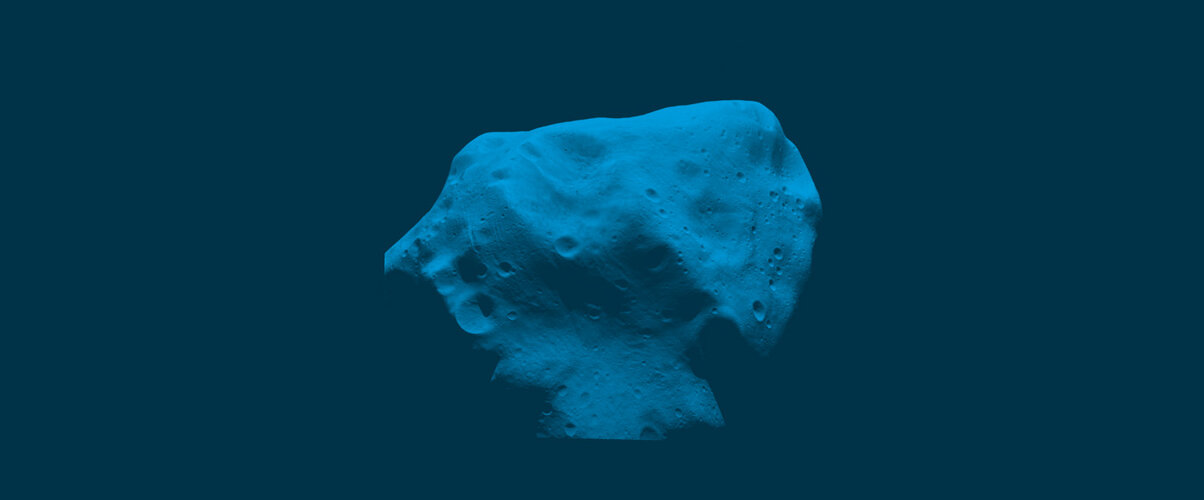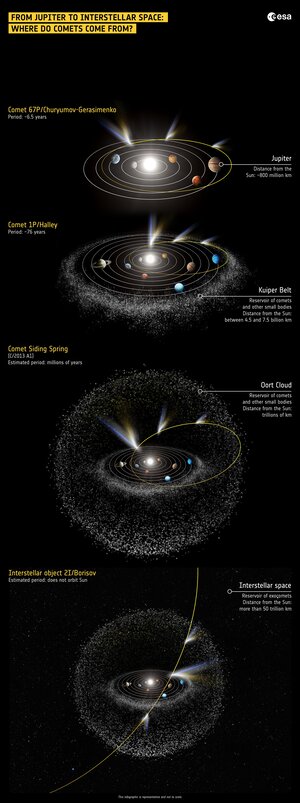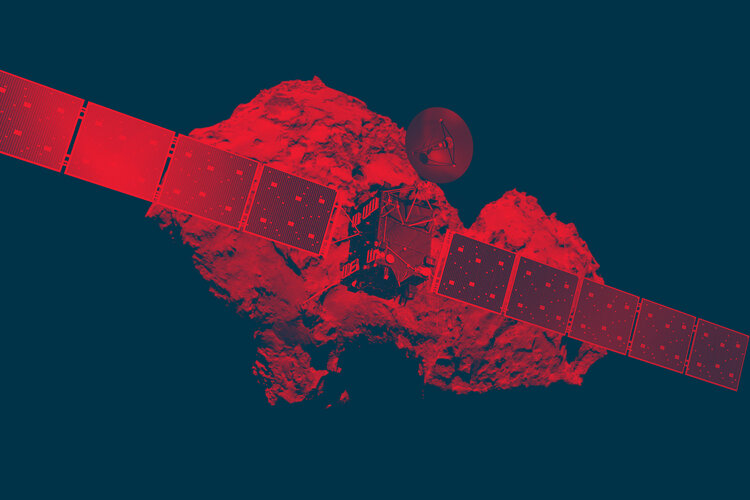‘Mother of Dragons’ comet visible in the night sky
What is happening?
Comet 12P/Pons-Brooks is visible in the night sky for observers in the northern hemisphere, offering a rare chance for professional and amateur astronomers to catch a glimpse of an object known for its spectacular outbursts of gas and dust.
Comet 12P/Pons-Brooks is a ‘Halley-type’ comet with an orbital period of roughly 71 years and a nucleus approximately 30 km wide. It has been observed during previous journeys through the inner Solar System, allowing astronomers to study its behaviour and characteristics over time.

Its distinctive shape has earned it the name ‘horned’ comet, or ‘devil’ comet, but we have chosen instead a pop-culture reference that draws on its role as the probable parent body of the ‘kappa-Draconids’, a small annual meteor shower that is active around 29 November to 13 December.
Like other comets, 12P/Pons-Brooks is composed of ice, dust, and rocky material. When it approaches the Sun, heat causes the ice inside the comet to turn from solid to gas.
The gas escapes from the surface of the comet, dragging dust with it. They form a large cloud and a tail that is pushed away from the Sun by the solar wind.
Where, when and how can I see the comet?

The visibility of comet 12P/Pons-Brooks varies. When it is highly active and close to Earth, it can appear very bright. Other times, it may appear only faintly.
The comet will reach its closet point to Earth in June 2024. However, by this time, it won’t be possible to observe the comet from the northern hemisphere. Late March and early April will offer the best opportunities.
During this time, the comet will be visible in clear dark skies above the western horizon during the hours after dusk. If you are lucky, it may be possible to observe it with binoculars, or even the naked eye, but you will have a better chance with even a small telescope, as its brightness is unpredictable.
Comet 12P/Pons-Brooks won’t return to our night skies until 2095.
Discovery and previous appearances

Comet 12P/Pons-Brooks is named after two of the most prolific comet observers of all time.
French astronomer Jean-Louis Pons (1761–1831) made most of his discoveries using telescopes and lenses of his own design. Pons made 37 visual comet discoveries between 1801 and 1827 – a record still held today.
One of his discoveries was made on 12 July 1812, when Pons spotted a dim object that initially lacked the iconic tail of a comet.
Over the next month, the comet became bright enough to be seen with the naked eye. On 15 August that year, it reached its peak brightness and featured a distinct tail.
Astronomers calculated the orbit of the comet based on Pons’ observations and suggested that the new comet had an orbital period around the Sun of between 65 and 75 years.

British-American astronomer William R. Brooks (1844–1921) accidently verified these calculations during the comet’s next trip through the inner Solar System.
Brooks was also prolific: his total of 27 comet discoveries is second only to Pons. But it soon became apparent that the ‘new’ comet he spotted on 2 September 1883 was actually the same one discovered by his spiritual rival 71 years earlier.
Due to the dual nature of the discovery, comet 12P now bears the names of both astronomers.
12P/Pons-Brooks went on to become famous for the sudden outbursts of gas and dust observed during its approach to the Sun in 1883, 1954 and 2023. It is thought that records of bright objects in the night sky from China in 1385 and Italy in 1457 could be observations of 12P/Pons-Brooks.
Why are comets interesting?

Comets are ancient cosmic icebergs. They are roughly 4.6 billion years old and formed at the same time as the Sun, Earth and the other planets.
Gravitational interactions fling them towards the inner planets from out beyond the orbit of Neptune, making them some of the most chaotic and dynamically interesting objects in the Solar System.
A comet’s nucleus is typically between 1 and 50 km across with the structure of a dirty snowball. They are made of dust and ice, which partly goes from solid to gas when the comet is warmed by the Sun. Cometary and asteroid impacts may be responsible for a fraction of the water present on Earth and for the icy reservoirs that are thought to exist at the bottom of permanently shadowed craters on the Moon.
The defining characteristic of a comet is its tails. Tails come in two main types, a dust tail and an ion (or plasma) tail. When sunlight warms the ice on a comet, gas and dust are released into space.
The dust falls into orbit around the comet and is gently pushed into fan-shaped tail by incoming sunlight.
The gas is ionised by ultraviolet sunlight and the particles of the solar wind, and these charged particles (ions) form a narrow ion tail that is pushed directly away from the Sun by the solar wind.
Comet tails are the reason for Earth’s annual meteor showers, during which Earth passes through clouds of dust left behind by comets.
Comet 12P/Pons-Brooks is a ‘near-Earth comet’, which means it orbits the Sun in less than 200 years and comes close enough to the Sun that it could cross Earth’s orbit. ESA’s Planetary Defence Office keeps a close eye on near-Earth comets to monitor any risk of collision.
Near-Earth comets are much rarer than near-Earth asteroids – their less icy cousins. We know of only 122 near-Earth comets, but of almost 35 000 near-Earth asteroids.
ESA missions to comets and asteroids

Seeing comets from afar can be beautiful, but to really get to know them, you have to study them up close.
ESA has developed and flown a number of spacecraft to comets and asteroids to improve our understanding of the formation and evolution of the Solar System, the role of these objects in delivering the ingredients of life to Earth, how comet activity works, and the risks these fast-moving space rocks pose to our planet.
Giotto
Giotto was ESA’s first deep-space mission. In 1986, it passed closest to the nucleus of comet Halley. It imaged a comet nucleus for the first time and found the first evidence of organic material on a comet. In 1992, after a long cruise through space, Giotto was directed to comet Grigg–Skjellerup, which it passed just 200 km from the nucleus.
Rosetta
Rosetta was the first spacecraft to rendezvous with a comet when it arrived at 67P/ Churyumov–Gerasimenko on 6 August 2014 and entered orbit around it. It was the first spacecraft to follow a comet on its journey around the Sun and measure the increase in activity as the icy surface warmed up. On 12 November 2024, Rosetta’s Philae probe became the first to land on the surface of a comet. On the way, it also flew by two asteroids, Steins and Lutetia.
Hera
Launching later this year, the Hera mission is part of the world’s first test of asteroid deflection. The main spacecraft and its two CubeSats will perform a detailed post-impact survey of the asteroid Dimorphos following the impact of NASA’s DART mission in September 2022. Hera will turn the grand-scale experiment into a well-understood and repeatable planetary defence technique.

Mission to Apophis
Meanwhile, ESA’s Planetary Defence Office is also considering a number of options for a mission to asteroid Apophis. In April 2029, Apophis will come closer to Earth than our geostationary satellites and will be visible to the naked eye. The trajectory of Apophis is very well known, and it poses no risk to Earth, but it offers a unique chance to study such a large asteroid up close and better prepare for one that is.
Comet Interceptor
Looking further ahead, ESA’s future Comet Interceptor will build on the findings of Giotto and Rosetta. Comet 12P/Pons-Brooks is a returning comet that has made a number of previous appearances over the centuries. Launching in 2029, the unique aspect of the Comet Interceptor mission is that it will target a newly discovered comet entering the inner Solar System for the first time. Such a ‘pristine’ comet would carry material unaltered since the formation of the planets.
Special mention: SOHO
While not a dedicated comet mission, no list of prolific comet observers would be complete without mentioning the ESA/NASA Solar Heliospheric Observatory (SOHO). SOHO provides new views of the Sun’s atmosphere and interior, but small, previously undiscovered, Sun-grazing comets often pass through its field of view on the way to their fiery demise. While Pons and Brooks still hold the top spots for visual discoveries, we now spot most new comets using large telescopes either on Earth or on satellites in orbit. SOHO recently discovered its 5000th comet.















 Germany
Germany
 Austria
Austria
 Belgium
Belgium
 Denmark
Denmark
 Spain
Spain
 Estonia
Estonia
 Finland
Finland
 France
France
 Greece
Greece
 Hungary
Hungary
 Ireland
Ireland
 Italy
Italy
 Luxembourg
Luxembourg
 Norway
Norway
 The Netherlands
The Netherlands
 Poland
Poland
 Portugal
Portugal
 Czechia
Czechia
 Romania
Romania
 United Kingdom
United Kingdom
 Slovenia
Slovenia
 Sweden
Sweden
 Switzerland
Switzerland





































